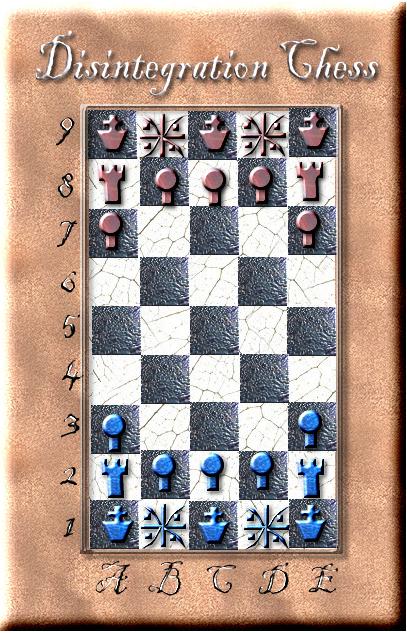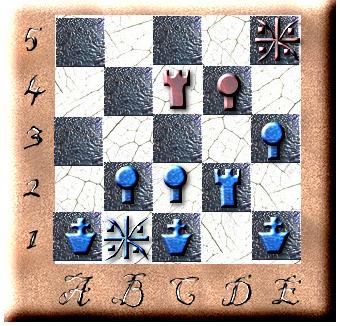Disintegration Chess
 "Disintegration Chess" is an entry for the 45/46 square contest.
The board was modified to the 9x5 board seen above.*
Object of the game: Disintegrate your opponent's 3 Kings.
(Put each of the three Kings into check.)
Putting a King in check causes it to disintegrate. Only Kings disintegrate. Pawns and pieces are removed only by displacement.
*See the notes section regarding an earlier 7x7 based board and the reason for changing to the 9-ranked board.
Note: a working pre-set is at this link:
http://play.chessvariants.org/pbm/play.php?game%3DDisintegration+Chess%26settings%3DDC
Plans are to make a pre-set that looks similar to the above image.
"Disintegration Chess" is an entry for the 45/46 square contest.
The board was modified to the 9x5 board seen above.*
Object of the game: Disintegrate your opponent's 3 Kings.
(Put each of the three Kings into check.)
Putting a King in check causes it to disintegrate. Only Kings disintegrate. Pawns and pieces are removed only by displacement.
*See the notes section regarding an earlier 7x7 based board and the reason for changing to the 9-ranked board.
Note: a working pre-set is at this link:
http://play.chessvariants.org/pbm/play.php?game%3DDisintegration+Chess%26settings%3DDC
Plans are to make a pre-set that looks similar to the above image.
Setup
As in the Diagram.
Pieces
See Diagram: Pawn - As in Fide Chess, except Pawns on A and E can only move 1 space per turn. B, C, and D pawns can advance 2 spaces on their first turn and pawn en passant applies. Pawns on the last rank can promote on the last rank to a rook or Fye'tin. Rook - as in chess. Fye'tin - This piece is the opposite of Adrian Alvarez de la Campa's Templar. Thus the Fye'tin can slide one or two spaces horizontal or vertical, or it can move like an elephant by leaping over 1 space diagonally onto a second space. It can never move 1 diagonal space. It cannot give check on the space diagonally adjacent. King - As in Fide chess. But, when in check the King disintegrates.
Rules
Win by eliminating the three Kings of your opponent. Putting a King in check causes it to disintegrate... once in check you cannot block it or move out of it... the King instantly disintegrates when in check. Note that you can't capture a King by displacement because it would disintegrate as soon as it was in the line of fire. You can move a piece that is "pinned" to a King.... but your King instantly disintegrates. Kings can also move into check and instantly disintegrate. Why would they do this? For example: If you have two Kings and your opponent has one, you can move one of your Kings next to his... both your King and his would instantly disintegrate. If Black should lose his last King he is granted 1 last move. If he can check your last King(s) on that turn, the game is a Draw. It is possible to disintegrate 2 or 3 Kings on 1 turn. There is no castling, no pawn en passant. Examples of disintegration: In this diagram, with Balck (Red) to move there are several disintigration options:
(A) Red Rook c4-a4: King on A1 disintegrates and is removed from board.
(B) Red Rook c4 x c2: king on C1 disintegrates and is removed.
(C) Fye'tin on e5 x e3: Kings on C1 and E1 disintegrate and are removed.
(D) Fye'tin on e5 - c3: Kings on A1 and E1 disintegrate and are removed. The King on c1 is safe because Fye'tins have no orthoganal leap.
An Important Concept: CHAIN REACTIONS due to DISINTEGRATIONS.
In this diagram, with Balck (Red) to move there are several disintigration options:
(A) Red Rook c4-a4: King on A1 disintegrates and is removed from board.
(B) Red Rook c4 x c2: king on C1 disintegrates and is removed.
(C) Fye'tin on e5 x e3: Kings on C1 and E1 disintegrate and are removed.
(D) Fye'tin on e5 - c3: Kings on A1 and E1 disintegrate and are removed. The King on c1 is safe because Fye'tins have no orthoganal leap.
An Important Concept: CHAIN REACTIONS due to DISINTEGRATIONS.
Notes
The Fye'tin was inspired by Adrian Alvarez de la Campa's "Templar" piece (found in his excellent game Templar). Movement was simply made opposite. If the Fye'tin exists somewhere under a different name I can rename it later... currently I am not aware of it existing elsewhere. The Fye'tin image - The plus shape indicates the 2-move slide. The curves over a small image represent the "leap over a square" aspect. The following text concerns the original board and why it was replaced. The original board was 7 x 7 with four corners removed. I like the looks of it. As George Duke has stated, this was the same technique used in Horus' 7x7 with the same 4 corners removed and there also the central square... Anyway, I do believe the 7 x 7 board is visually more interesting. However, Abdul-Rahman Sibahi wanted to see an example of disintegration. I then added a few moves to show what could be considered a standard opening and a defense to it. On the 7 x 7 board White (Blue) can use a Fye-tin to quickly go for a double-disintegration. He does this by getting a Fye'tin to check Red's (Black's) two corner Kings. Red, knowing this, will move one King out of the check area. The question is, "Is the Fye'tin worth this one King?" This 'user submitted' page is a collaboration between the posting user and the Chess Variant Pages. Registered contributors to the Chess Variant Pages have the ability to post their own works, subject to review and editing by the Chess Variant Pages Editorial Staff.
This 'user submitted' page is a collaboration between the posting user and the Chess Variant Pages. Registered contributors to the Chess Variant Pages have the ability to post their own works, subject to review and editing by the Chess Variant Pages Editorial Staff.
By Gary K. Gifford.
Web page created: 2007-09-11. Web page last updated: 2007-09-16
